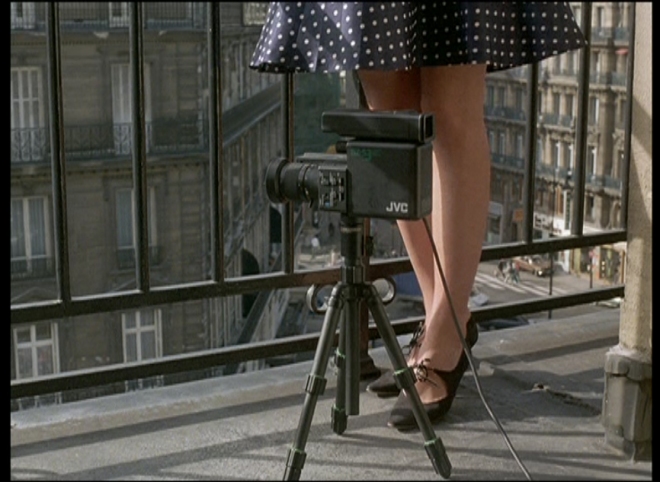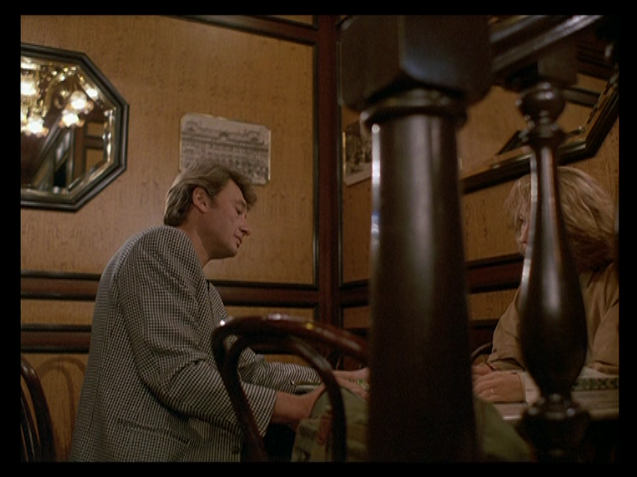In Akira Kurosawa’s Rashomon and George Miller’s Mad Max it is undeniable that violence is a key and extremely prevalent theme. The different ways in which violence is portrayed, however, is crucial to the plot, the narrative, the characters and, most importantly, the success of both of these films.
Rashomon

In Rashomon, Kurosawa uses lighting selectively to create an atmosphere of danger and to suggest or imply violence. Shadows are placed on the bandit’s face, immediately presenting him in a darkened light and, therefore, identifying him as the ‘bad guy’ and thus, the character most likely to be violent. Furthermore, the film is set in a dense forest. As a result, the steady beams of sunlight flicker and are disrupted by the trees, thus creating shadows that move continually over the faces of the characters. This renders “dense thickets as poetic metaphors…that entrap human beings”[1]. This disrupted image distorts the audience’s view of the characters, and therefore forbids an objective view being cast. In addition, this sets the violent moments of the film out of the audience’s view, casting some moments in shadow or blinding the audience with the glare of sunlight. The full extent of the violence, therefore, is unknown. This unknown is left to the imagination of the audience member. This is most apparent in, the bandit, Tajomaru’s version of events. During his rape of Masago, the camera scans to the sky creating a deliberate glare and dream-like feel to the scene. “Shooting directly into the sun to make the camera lens flare”1 and “probing the filaments of shadows in glade and clearing”1 roots this violent act in a fantasy world, out of reality and into the imagination of the audience. They, as a result, are left to decide the fate of Masago using their expectations, thoughts, dreams and fantasies, making the viewers of the film voyeurs. Kurosawa is commenting on the unconscious desires of his characters but is also allowing his audience’s unconscious desires to be satisfied through the mystery of violence. By portraying violence in this way, the audience is as much a part of the film’s jury as the judge, or the other characters, in their ultimate quest for truth.
Kurosawa’s films have often been compared with the silent movies of the early twentieth century; Rashomon is no exception. Kurosawa has been described as “consciously attempting to recover and recreate the aesthetic glory of silent filmmaking”[2]. Many scenes are “composed as silent sequences of pure film”2 in which the action is reliant upon ambient sound, music, facial expressions and body language. This alters the portrayal of violence in the film, in comparison with a typical horror or violent action movie. In the woodcutter’s long marching scene, it is the minor-key music that generates a dangerous military atmosphere and creates the expectation of violence. Sounds are coordinated with the actions of characters, just as in a silent movie, so that when this music is repeated, violence is not only expected, but is essential to the upkeep of the films “aesthetic glory”2. Camera angle and shooting is also important in the portrayal of violence and is fundamental to continuing the silent movie effect. In the bandit’s version of events, he murders Takehiro, the samurai. In this scene, there is reliance upon body language and an emphasis on facial expression, typical of the silent movie melodramatic acting style. During the murder, the camera zooms in on the bandit’s face to show his psychological reaction. This intensifies the audience’s experience of the violence. Furthermore, the camera angle forces the audience into the samurai’s position so they experience, through their imagination, what the samurai is experiencing.
Mad Max

In Mad Max, Miller articulates the destruction of civilization through the portrayal of violence. It is significant at the beginning of the film that a rural-urban distinction allows for distance and separation between violence and peace – for instance, the innocent child and families found in the town areas and the Night Rider and motorcycle gangs found on the rural highways. However, the motorcycle gang cross this divide, infecting the civilization of the town with violence, death and destruction; no longer contained by boundaries. A cyclic feeling is emphasised by the significant use of cars and motorcycles. As the film progresses, this cyclic feeling begins to parallel the developing pattern of violence as the motorcycle gang encroach more and more upon the urban, the civilized and society. Max and his family try to escape the failing justice system, and the violence that lies hand in hand with the motorcycle gang, by travelling around the country. Dissolve shots are used between these scenes to imply that a significant amount of time and distance has passed. However, the motorcycle gang eventually manage to find them and invade the most rural setting so far, the farm. The rural-urban distinction is, therefore, lost along with the violence-peace distinction. Place names are no longer used and boundaries blur into one another, highlighting the loss of civilization and dominance of violence, death and destruction. In this way, Miller portrays violence through the manipulation of landscape, scenery and the traditional ‘road movie’ concept.
Miller uses the psychological decline of Max, from hero to mad man, to portray violence in the film. At the end of the film, there are powerful moments of inversion as Max begins to display actions and moral reasoning similar to those of the motorcycle gang. The Australian Gothic genre is described as having narratives that “transplant their protagonists to create unease and alienation.”[3] Max is transplanted from his world of stability and justice to insanity and violence. Mirroring of relationships can be found all the way through the film with similarities seen between Max’s relationship with his son and the Toecutter’s relationship with Johnny the boy. Max’s violent murder of Johnny the boy at the end of the film can be seen not only as a true act of revenge, but also as Max’s final fall into madness, the overthrow of justice and the destruction of civilization.
Rashomon is described as having a “daring, nonlinear approach to narrative”[4]. The continual use of flashbacks means that “the narrative continually retraces the same series of events, four times over”. This unique narrative style causes the audience to focus on the multiple versions and interpretations of one violent event; the rape of a woman and murder of a samurai. The violence and violent acts, therefore, become the narrative; they are the story, the reason by which we judge the characters and the focus of our viewing. The cast is small and the flashbacks are many, so the characters’ personalities are developed and questioned more intensely than in a conventional film setup. As a result, the psychological turmoil of the characters is examined in depth, binding the audience to their angst. This means the experience of violence is heightened for both the characters and the audience.
In both Mad Max and Rashomon differences can be seen in the treatment of men and women, particularly in relation to violence. In Rashomon, the women, Masago, admits, in her version of events, to killing her husband. The camera dwells on her face for a long period of time before the killing and there are many close-up shots. This focuses the audience’s attention on Masago’s inner turmoil. Her mind goes through many different stages of thought as she decides how to react to the intense look of disgust she receives from her husband. Violence, in this scene, is portrayed as Masago’s only option of empowerment after she has been disgraced by Tajomaru, the bandit. Freudian psychology identified the unconscious mind as extremely important in the repression of sexual desires that would usually be seen as culturally or socially unacceptable. Freud himself believed women were inferior and that femininity was failed masculinity. As a result, in the psychosexual stages of development, women develop penis envy. Masago demands sexual authority, gender equality and satisfies penis envy, by killing her husband with a dagger – a phallic symbol of male sexual power. The weapons seen in Rashomon are often highlighted through bright lighting. Sunlight on the woodcutter’s axe and the samurai’s sword, for instance, glimmers and shimmers off of the metal. This beautifies and glorifies them, in turn, beautifying and glorifying the violence that they cause. So, when Masago kills her husband with a dagger, it is the ultimate act of glory, dominance and power. This struggle for power is further emphasised through the use of lighting and colour. Masago is presented beautifully in white clothing and with a white veil as a symbol of purity. This, therefore, emphasises the brutality of the bandit’s rape; that something so pure is so cruelly violated. Furthermore, before Masago kills Takehiro, her husband, shadows appear more and more on her face. Her pure white face is distorted by dark lighting and shadow as her innocent exterior is tainted by her desire for power and violence. In this way, violence is portrayed through gender conventions and as a result of the psychological desire for sexual power.
In Mad Max, it is through the emasculation of male characters that Miller portrays violence and the corruption of a justice system. The police force have an almost hyper-masculine appearance at the start of the film; black leather, muscles, cars, explosions etc. The cars, particularly, are significant as physical symbols of a way in which men can assert their masculinity; large engines, speed, long exhausts and power. But this image, including Max’s, is broken down through continual violence and the film becomes subversive in its attitudes to masculinity. The masculine character of Fifi Macaffee, for example, is seen later in the film watering plants with romantic music playing in the background. This is highly contradictory of the gender stereotypes that are seen originally in the film. For instance, the masculinity of the police force is exemplified in the chase of the Night Rider. Max takes control of the situation and reduces the, once stereotypically masculine and “fuel-injected”[5], Night Rider to tears showing his loss of power. However, as the film develops and the motorcycle gang’s violence increases, Max’s masculinity, and that of the police force, is destroyed. The motorcycle gang do not use guns as weapons as much as they use chains, ropes, axes etc. The phallic implications found in using these long objects as weapons shows that, through violence, the motorcycle gang can demand sexual power. Violence, therefore, is presented as the only way in which Max can gain back his masculinity and take ultimate revenge on the criminals. The original heroism conventions are, now, ambiguous and corrupt. Max has experienced heroism and was able to gain masculinity and power through that, but, now, he is forced to resort to violence. Violence is, therefore, portrayed through a polarised view of the power struggle between good and evil, hero and villain, acceptance and revenge.
[1] Peter Lehman and William Lehr, ‘Jurassic Park and Rashomon’, in
Thinking about movies, (USA: Blackwell, 2003), p.27-50.
[2] Stephen Prince, ‘Rashomon’, The Criterion Collection, <http://www.criterion.com/asp/release.asp?id=138&eid=212§ion=essay&page=1> [accessed 18 January 2008].
[3] Jonathon Rayner, Contemporary Australian Cinema: An Introduction, (Manchester, Manchester University Press: 2000), p.24-25.
[4] Stephen Prince, ‘Rashomon’, The Criterion Collection, <http://www.criterion.com/asp/release.asp?id=138&eid=212§ion=essay&page=1> [accessed 18 January 2008].
[5] Mad Max, Dir. George Miller, Kennedy Miller Productions, 1979









 (the redeemer)
(the redeemer)

